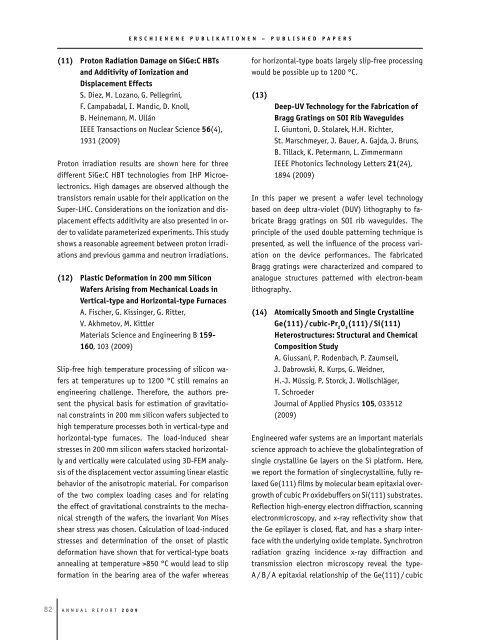Deliverables and Services - IHP Microelectronics
Deliverables and Services - IHP Microelectronics
Deliverables and Services - IHP Microelectronics
You also want an ePaper? Increase the reach of your titles
YUMPU automatically turns print PDFs into web optimized ePapers that Google loves.
82 A n n u A l R e p o R t 2 0 0 9<br />
e r S C H I e N e N e p u B L I K A t I o N e N – p u B L I S H e d p A p e r S<br />
(11) proton radiation damage on SiGe:C HBts<br />
<strong>and</strong> Additivity of Ionization <strong>and</strong><br />
displacement effects<br />
S. Diez, M. lozano, G. pellegrini,<br />
F. Campabadal, I. M<strong>and</strong>ic, D. Knoll,<br />
B. Heinemann, M. ullán<br />
Ieee transactions on nuclear Science 56(4),<br />
1931 (2009)<br />
proton irradiation results are shown here for three<br />
different SiGe:C HBt technologies from IHp <strong>Microelectronics</strong>.<br />
High damages are observed although the<br />
transistors remain usable for their application on the<br />
Super-lHC. Considerations on the ionization <strong>and</strong> displacement<br />
effects additivity are also presented in order<br />
to validate parameterized experiments. this study<br />
shows a reasonable agreement between proton irradiations<br />
<strong>and</strong> previous gamma <strong>and</strong> neutron irradiations.<br />
(12) plastic deformation in 200 mm Silicon<br />
wafers Arising from Mechanical Loads in<br />
Vertical-type <strong>and</strong> Horizontal-type Furnaces<br />
A. Fischer, G. Kissinger, G. Ritter,<br />
V. Akhmetov, M. Kittler<br />
Materials Science <strong>and</strong> engineering B 159-<br />
160, 103 (2009)<br />
Slip-free high temperature processing of silicon wafers<br />
at temperatures up to 1200 °C still remains an<br />
engineering challenge. therefore, the authors present<br />
the physical basis for estimation of gravitational<br />
constraints in 200 mm silicon wafers subjected to<br />
high temperature processes both in vertical-type <strong>and</strong><br />
horizontal-type furnaces. the load-induced shear<br />
stresses in 200 mm silicon wafers stacked horizontally<br />
<strong>and</strong> vertically were calculated using 3D-FeM analysis<br />
of the displacement vector assuming linear elastic<br />
behavior of the anisotropic material. For comparison<br />
of the two complex loading cases <strong>and</strong> for relating<br />
the effect of gravitational constraints to the mechanical<br />
strength of the wafers, the invariant Von Mises<br />
shear stress was chosen. Calculation of load-induced<br />
stresses <strong>and</strong> determination of the onset of plastic<br />
deformation have shown that for vertical-type boats<br />
annealing at temperature >850 °C would lead to slip<br />
formation in the bearing area of the wafer whereas<br />
for horizontal-type boats largely slip-free processing<br />
would be possible up to 1200 °C.<br />
(13)<br />
deep-uV technology for the Fabrication of<br />
Bragg Gratings on SoI rib waveguides<br />
I. Giuntoni, D. Stolarek, H.H. Richter,<br />
St. Marschmeyer, J. Bauer, A. Gajda, J. Bruns,<br />
B. tillack, K. petermann, l. Zimmermann<br />
Ieee photonics technology letters 21(24),<br />
1894 (2009)<br />
In this paper we present a wafer level technology<br />
based on deep ultra-violet (DuV) lithography to fabricate<br />
Bragg gratings on SoI rib waveguides. the<br />
principle of the used double patterning technique is<br />
presented, as well the influence of the process variation<br />
on the device performances. the fabricated<br />
Bragg gratings were characterized <strong>and</strong> compared to<br />
analogue structures patterned with electron-beam<br />
lithography.<br />
(14) Atomically Smooth <strong>and</strong> Single Crystalline<br />
Ge(111) / cubic-pr 2 o 3 (111) / Si(111)<br />
Heterostructures: Structural <strong>and</strong> Chemical<br />
Composition Study<br />
A. Giussani, p. Rodenbach, p. Zaumseil,<br />
J. Dabrowski, R. Kurps, G. Weidner,<br />
H.-J. Müssig, p. Storck, J. Wollschläger,<br />
t. Schroeder<br />
Journal of Applied physics 105, 033512<br />
(2009)<br />
engineered wafer systems are an important materials<br />
science approach to achieve the globalintegration of<br />
single crystalline Ge layers on the Si platform. Here,<br />
we report the formation of singlecrystalline, fully relaxed<br />
Ge(111) films by molecular beam epitaxial overgrowth<br />
of cubic pr oxidebuffers on Si(111) substrates.<br />
Reflection high-energy electron diffraction, scanning<br />
electronmicroscopy, <strong>and</strong> x-ray reflectivity show that<br />
the Ge epilayer is closed, flat, <strong>and</strong> has a sharp interface<br />
with the underlying oxide template. Synchrotron<br />
radiation grazing incidence x-ray diffraction <strong>and</strong><br />
transmission electron microscopy reveal the type-<br />
A / B / A epitaxial relationship of the Ge(111) / cubic










